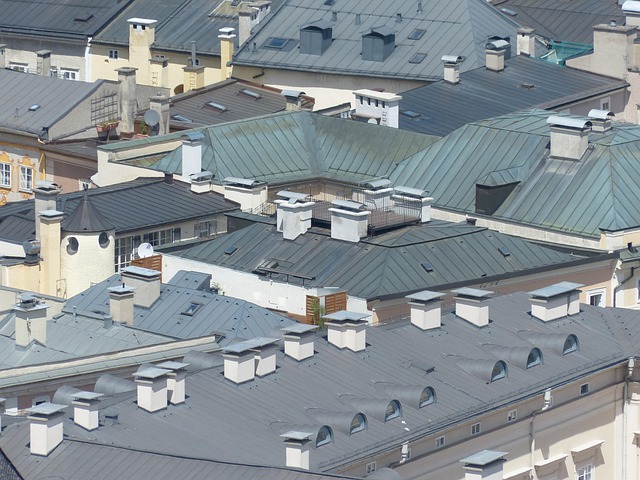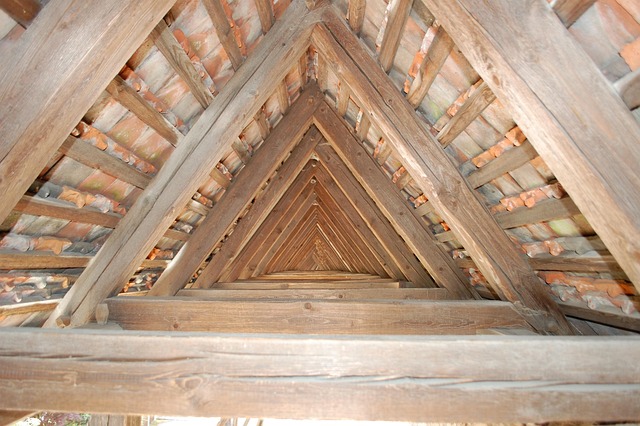Built-up roofing (BU) systems on flat commercial buildings offer superior protection with multi-ply layers, including bitumen membranes, reinforcement fabrics, felts, and gravel tops. This composition provides durability against water, temperature extremes, and debris while enhancing energy efficiency. Installation involves meticulous preparation, application of underlayers, waterproof barriers, multiple bitumen plies, and final sealing. Regular maintenance is crucial to combat UV damage, delaminations, and leaks, extending the roof's lifespan through inspections, repairs, proper cleaning, sealing, and ventilation.
“Unveiling the complexities of Built-Up Roofing (BU) systems, this comprehensive guide delves into their multifaceted role in commercial building construction. From the intricate layering of materials to their numerous advantages, we explore why BU roofs are a popular choice for flat commercial structures.
The article breaks down the installation process, offers insights on maintenance, and highlights potential challenges. Whether you’re an architect, contractor, or building owner, this resource provides valuable knowledge on optimizing BU roofing performance.”
- Understanding Built-Up Roofing Systems: A Comprehensive Overview
- Components and Layers of a Multi-Layered BU Roof
- Advantages and Benefits for Commercial Buildings
- Installation Process: Step-by-Step Guide
- Maintenance and Longevity: Ensuring Optimal Performance
- Common Challenges and Troubleshooting Tips
Understanding Built-Up Roofing Systems: A Comprehensive Overview

Built-up roofing systems are a common sight on flat commercial buildings, offering both durability and protection against the elements. These systems are created by layering multiple components—typically consisting of a base sheet, one or more intermediate layers of bitumen roofing, and a final layer of gravel or another protective coating. This multi-ply roof construction provides exceptional strength and weather resistance, making it ideal for industrial and commercial applications.
Understanding the makeup of these systems is crucial when considering their maintenance or replacement. The base sheet serves as the foundation, often made from strong materials like fiberglass or asphalt-impregnated felt. The bitumen roofing layers act as a binding agent, providing cohesion between sheets and enhancing the overall durability. Finally, the gravel or other protective topping offers a shield against UV damage, extreme temperatures, and potential debris impact, ensuring the roof’s longevity.
Components and Layers of a Multi-Layered BU Roof

A multi-layered built-up roofing (BU) system is a complex yet effective structure designed for flat commercial buildings. This type of roof consists of several components and layers, each playing a crucial role in providing superior protection against various environmental factors. The base layer typically involves a bitumen roofing membrane, which serves as the primary barrier against water intrusion. Over this, additional layers are added to enhance durability and insulation properties.
The subsequent layers often include a fabric reinforcement mat, followed by one or more plies of bitumen. On top of these, a gravel roof is commonly applied, offering protection against UV rays and providing extra weight to keep the system in place. This multi-ply roof design creates a robust shield, ensuring longevity and stability for commercial structures.
Advantages and Benefits for Commercial Buildings

Built-up roofing systems, a multi-layered approach often employed on flat commercial buildings, offer a plethora of advantages tailored to meet the unique needs of such structures. These systems are designed to withstand the rigours of diverse climates and provide long-lasting protection for the underlying surfaces. One of the primary benefits is their exceptional durability; multiple layers of bitumen roofing, separated by reinforcing fabrics or felts, create a robust barrier against water intrusion, extreme temperatures, and environmental stressors.
Moreover, built-up roofs facilitate efficient insulation, contributing to energy-efficient building operations. The multi-ply design acts as a thermal barrier, regulating interior temperatures and reducing the need for extensive heating or cooling systems. Additionally, these roofing systems offer versatility in terms of customisation; they can be designed with specific gravity requirements, allowing buildings to meet structural integrity standards while maintaining a flat profile. This adaptability makes built-up roofing an attractive choice for commercial structures, ensuring both aesthetic appeal and functional reliability.
Installation Process: Step-by-Step Guide

The installation process for a built-up roofing system is an intricate dance that requires precision and expertise. It involves multiple layers, each playing a crucial role in ensuring the roof’s durability and weather resistance. The journey begins with preparing the substrate, ensuring it’s clean, dry, and free from any debris. A hot asphalt or bitumen roofing underlayer is then carefully unrolled and smoothed out, forming the first protective barrier.
Following this, layers of felt paper or fabric are laid down, acting as a waterproof membrane. The key component, often referred to as a multi-ply roof or gravel roof, is then installed by strategically placing and smoothing a layer of aggregate (gravel) over the felt. This is followed by additional bitumen roofing layers, each reinforced with more felts, creating a robust and multi-layered defense against the elements. The final touches involve trimming the edges, ensuring proper flashing, and sealing any gaps, resulting in a seamless and secure roof.
Maintenance and Longevity: Ensuring Optimal Performance

Proper maintenance is key to extending the lifespan of multi-layered built-up roofing systems, ensuring optimal performance for commercial buildings. Regular inspections and timely repairs are essential to prevent minor issues from becoming major problems. Built-up roofing, often referred to as gravel roof or bitumen roofing, consists of multiple layers of fabric and bitumen, requiring specific care to maintain its integrity. For instance, checking for any signs of damage, such as punctures, tears, or loose flashing, should be a standard practice.
Additionally, keeping the surface clean and free from debris is crucial. Accumulated dirt and grime can impact water drainage, leading to potential leaks. A well-maintained multi-ply roof not only preserves its structural integrity but also ensures energy efficiency by maintaining optimal temperatures inside the building. This long-lasting roofing solution benefits from regular cleaning, sealing any gaps or cracks, and ensuring proper ventilation to prevent excessive heat build-up, thereby enhancing the overall sustainability of commercial structures.
Common Challenges and Troubleshooting Tips

Built-up roofing systems, while robust and popular for flat commercial buildings, come with their share of challenges. One common issue is the potential for damage from ultraviolet (UV) radiation, which can weaken the bitumen roofing material over time, leading to leaks. To mitigate this, regular inspection and reapplication of protective coatings are essential maintenance steps.
Another challenge arises from the multi-ply nature of these systems, where layers of fabric and bitumen are stacked. Improper installation or poor weather conditions during application can result in a gravel roof that doesn’t adhere properly, increasing the risk of delaminations. Troubleshooting tips include ensuring skilled labor for installations and repairs, using high-quality materials, and addressing any issues promptly to prevent further damage. For example, if a layer is damaged, removing the affected area and reapplying bitumen roofing can restore integrity to the multi-ply roof.
